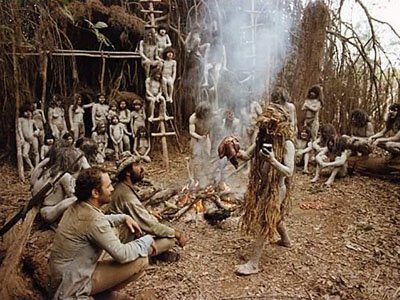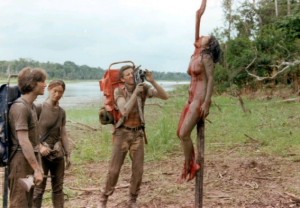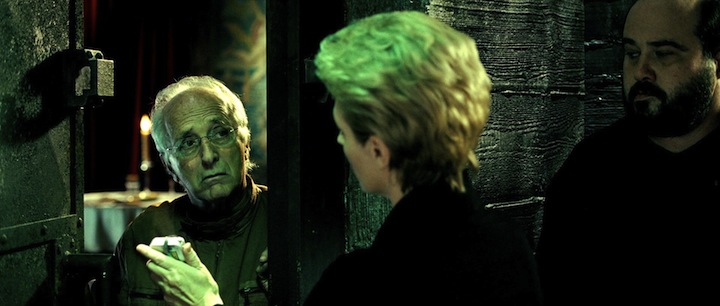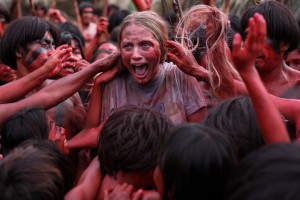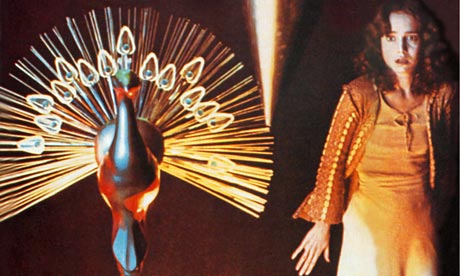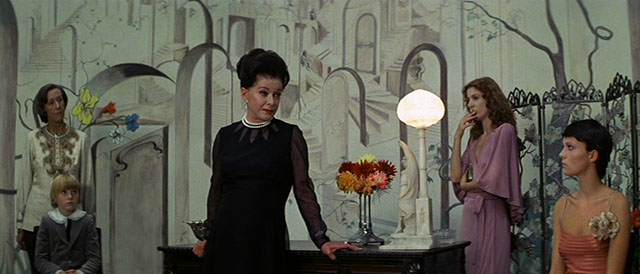Since Atlanta has become such a classic monster movie kind of city, ATLRetro presents the first in an ongoing new feature, CINEMA ATLRETRO MACABRE, featuring exclusive interviews with the masters and mistress of 20th century horror films. Our intrepid Retro Reviewer Andrew Kemp caught up with Ruggero Deodato, director of CANNIBAL HOLOCAUST (1980), last fall at the Twisted Fears convention. A special thanks also goes to Sandra Despirt, who translated the taped interview from Italian into English. Watch for our next interview with Barbara Steele soon.
By Andrew Kemp
Contributing Writer
We’re done talking, but the elderly gentleman holds me up for a second. He smiles and palms me a tiny wrapped piece of candy. He has, I swear, an actual twinkle in his eye. The gesture reminds me of something a movie grandpa might do, and the man—warm sweater, round glasses and with one last tuft of unruly white hair atop his head—certainly fits the role. I half-expect to find a golden Werther’s Original in my hand, but it turns out to be a fun-sized Milky Way. It’s not what I expect, but I can’t stop smiling at the thought that Ruggero Deodato just handed me a little morsel of something to eat.
Moments earlier that kindly old man, speaking to me in Italian with a translator, expressed bewilderment at his place in cinema infamy. “What I find incredible is that when I ask young people what they find more disturbing—my movie, CANNIBAL HOLOCAUST or the film of the real beheading of an American in Iraq—and they reply CANNIBAL HOLOCAUST,” he says. “Incredible, very disturbing.” Over 30 years after Deodato’s cannibal opus, the director still appears surprised at the power of what he made, even though he remains to this day one of the few film directors forced to produce his actors in the flesh simply to prove to authorities that they were still alive. Clearly, there’s just something about his film that digs beneath the skin.
CANNIBAL HOLOCAUST (1980) is one of cinema’s great provocations. A late entry into the brief Italian subgenre of cannibal movies, the film is alternately credited with canonizing the genre or destroying it, or sometimes both in the same breath. The film concerns a documentary crew that traipses into the Amazon to acquire rare footage of a savage, stone-age tribe of locals who may or may not engage in cannibalism. The title, I guess, is a spoiler. Suffice to say that no good comes to the crew, or to pretty much anyone else, including some unfortunate animals butchered on camera. Unlike the crew “deaths” that fooled the Italian courts, the animal torture is regrettably unsimulated. In the past, Deodato has claimed he was only filming a fact of daily life for the local tribes, that animals were routinely slaughtered in such a way for food and materials, not simply for his cameras. (A similar argument has always been made by Francis Ford Coppola about the bull death that closes APOCALYPSE NOW [1979]). Still, if you plan to see the film, consider the state of your stomach.
Central to the movie’s ability to unsettle is the way Deodato frames the movie as a documentary and shoots it accordingly. Today, we know what that should look like, but nothing else quite like CANNIBAL HOLOCAUST existed at the time. Already established in cannibal cred after his 1977 LAST CANNIBAL WORLD [aka JUNGLE HOLOCAUST], Deodato found inspiration for his new technique much closer to home. “I had already made the film LAST CANNIBAL WORLD, which was a big success, especially in Japan. I ultimately decided to make CANNIBAL HOLOCAUST when terrorism [the Red Brigades] was almost a daily occurrence in Italy and my 7-year -old son asked me why there were so many horrific images on TV, casualties of these acts of terrorism. I thought to myself, hey, why is it that journalists can get away with it and I can’t? If I make a film, they cut it, so I decided to make this movie as a statement against the journalists and censorship.”
Although Italian media may have been the inspiration, Deodato’s film had a global impact because it tapped into the rise of media violence being beamed into televisions everywhere, including those seen in American living rooms every night during the Vietnam War, still a fresh wound in 1980. The brutality and realism of Deodato’s images rankled the public. It felt real, with none of those distancing effects that make movies so much fun to watch. A cult classic was born. CANNIBAL HOLOCAUST became so notorious that other directors had difficulty launching their own cannibal productions, and the bubble quickly burst. Deodato’s was a tough act to follow.
In recent years, Deodato is seen less as a rebel and more as a horror pioneer. The journalistic style Deodato developed in 1980 is today called by another name: found footage. Both fans and critics of the now-ubiquitous genre usually point to THE BLAIR WITCH PROJECT (1999) as the movie that brought shaky cameras and screaming amateur actors into the mainstream, but it’s hard to watch those mapless teens die in the Massachusetts woods, or to remember the internet buzz the accompanied the film, without noting that Deodato got there almost 20 years earlier. Don’t expect Deodato to be proud of all of his misbegotten children. “Unfortunately my idea has ruined movie-making to some extent because there are those that think all they need to have is a small camera and [to] start shooting without consideration for technique or storyline development.”
“When I see films that have truly been inspired by my CANNIBAL HOLOCAUST, I’m very happy, but not when they start putting in zombies, aliens and vampires,” he adds. “I hate that.”
Eli Roth is one Deodato admirer who not only shares the director’s taste for horror realism but also prefers to populate his pictures with sadistic human monsters rather than ghosts and ghoulies. After breaking out with the disease gorefest CABIN FEVER (2002), Roth became a spiritual successor to Deodato with his HOSTEL series, replacing clueless journalists with clueless American teens whose condescension to Europe and lust for booze and sex make them prey for sinister millionaires willing to pay big bucks to kill. Roth wears his influences on his sleeve, adding a wink to this in HOSTEL PART II (2007) by casting Deodato as a cultured cannibal in one of the film’s more memorable gross-outs. Roth’s latest effort, THE GREEN INFERNO (2013), takes another step in Deodato’s direction by reigniting the cannibal drama. In Roth’s film, again it’s the naïve outsiders who are torn apart by the natives they were hoping to protect. “Thirty-three years have passed and I’m still being imitated,” Deodato says. “Eli Roth is a friend of mine so at the end of his movie he did an homage to me by saying in the credits – To Ruggero.”
The warmth that Deodato has for Roth doesn’t extend much further, it seems. I asked him about the current state of horror, how nobody seems to be terrorizing and disturbing audiences quite the way he did. “LAST CANNIBAL WORLD was filmed in the black jungle of Malaysia,” he notes. “For CANNIBAL HOLOCAUST, I was filming in the middle of the Amazon with indigenous tribes. Back in those days, people still didn’t know about a lot of things so when you came across a tribe in the middle of the jungle that was something. Now people travel everywhere. People were more easily shocked. It is much more difficult to do so now.”
Later, sitting on a panel with other Italian horror cinema legends Lamberto Bava and Barbara Steele, Deodato reminds me once more of a kindly old gentleman. When asked about horror cinema, he confesses that he doesn’t much like the genre anymore, noting his preference for dramas and romances. I think back on the story of the “murdered” actors he had to produce in court, and recall that even after the actors appeared, not all of the charges were dropped. Such was the impact of Deodato’s gore that to be fully cleared, the director first had to first demonstrate to court officials exactly how he had accomplished a signature, grotesque impalement with special effects. I think the prosecutor in question just wanted to get that particularly nasty bit out of his head.
Andrew Kemp is a screenwriter and game designer who started talking about movies in 1984 and got stuck that way. He can be seen around town wherever there are movies, cheap beer and little else.


